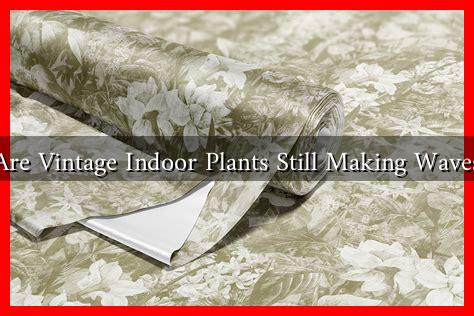-
Table of Contents
Are Vintage Indoor Plants Still Making Waves?
In recent years, the trend of indoor gardening has surged, with many people turning to plants not just for their aesthetic appeal but also for their health benefits. Among these, vintage indoor plants—those that were popular in previous decades—have made a significant comeback. But are they still making waves in today’s modern homes? This article explores the resurgence of vintage indoor plants, their benefits, and how they fit into contemporary decor.
The Resurgence of Vintage Indoor Plants
Vintage indoor plants refer to species that were once widely cultivated and cherished, often seen in homes during the mid-20th century. Plants like the Spider Plant, Pothos, and Peace Lily have re-emerged as favorites among plant enthusiasts. This revival can be attributed to several factors:
- Nostalgia: Many people are drawn to vintage plants due to their childhood memories or family connections.
- Low Maintenance: Many vintage plants are hardy and require minimal care, making them ideal for busy lifestyles.
- Air Purification: Studies have shown that certain vintage plants can improve indoor air quality, a significant concern in urban living.
Health Benefits of Vintage Indoor Plants
Beyond their aesthetic appeal, vintage indoor plants offer numerous health benefits. According to a study by NASA, certain plants can remove toxins from the air, making them essential for a healthy living environment. Here are some notable examples:
- Spider Plant (Chlorophytum comosum): Known for its ability to remove formaldehyde and xylene from the air.
- Peace Lily (Spathiphyllum): Effective in filtering out ammonia, benzene, and other harmful chemicals.
- Pothos (Epipremnum aureum): A resilient plant that thrives in low light and helps reduce indoor pollutants.
Incorporating these plants into your home can lead to improved air quality, which is particularly beneficial for individuals with allergies or respiratory issues.
Vintage Plants in Modern Decor
As interior design trends evolve, vintage indoor plants have found their place in contemporary decor. They add a touch of nostalgia while complementing modern aesthetics. Here are some ways to incorporate vintage plants into your home:
- Mix and Match: Combine vintage plants with modern decor elements to create a unique look.
- Use Vintage Pots: Displaying plants in retro pots can enhance their vintage appeal.
- Group Plants: Create a plant corner with various vintage species for a lush, green atmosphere.
For inspiration, platforms like Pinterest and Instagram are filled with creative ideas on how to style vintage plants in your home.
Case Studies: The Popularity of Vintage Plants
Several case studies highlight the growing popularity of vintage indoor plants. For instance, a survey conducted by the National Gardening Association found that 35% of households in the U.S. have indoor plants, with vintage varieties being among the top choices. Additionally, local plant shops have reported a 50% increase in sales of vintage plants over the past two years, indicating a strong consumer interest.
Moreover, social media influencers and gardening bloggers have played a significant role in promoting these plants, showcasing their beauty and ease of care. The hashtag #VintagePlants has gained traction, with thousands of posts celebrating these green companions.
Conclusion: The Lasting Appeal of Vintage Indoor Plants
In conclusion, vintage indoor plants are not just a fleeting trend; they are making waves in the world of indoor gardening for good reason. Their nostalgic charm, health benefits, and compatibility with modern decor make them a favorite among plant lovers. As more people seek to create green spaces in their homes, vintage plants will likely continue to thrive, proving that some trends are indeed timeless.
For those looking to explore the world of vintage indoor plants further, resources like House Plant Journal offer valuable insights and tips on care and styling.

